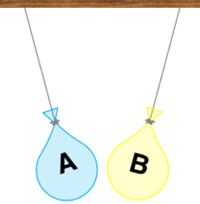It's All About Reasoning
Like a lot of our Concept Builders (but maybe more so with this one), you have some thinking and logical reasoning to do. The physics rules are straight-forward:
- opposites attract,
- likes repel, and
- charged and neutral attract.
But the application of these simple rules can get complicated. Get yourself organized and prepare to reason.
The Game Plan
The charge of Balloon A is stated. Observe how it interacts with Balloon B. Ask yourself if the diagram displays attraction or repulsion. Then look up the corresponding rule - they're listed in the paragraph above - It's All About Reasoning. It's important to note that there are two rules for explaining why attraction occurs. There's more on the logical significance of this in the next two paragraphs.
Repulsion Provides Evidence for Clear Conclusions
There is only one reason for why two objects repel - they have the same type of charge. Neutral objects can never be involved in repulsion. So if you observe that Balloons A and B repel, you know that they are both charged and charged with the same type of charge. Repulsion always leads to very clear conclusions about the charge type of objects.
Careful about Attraction
There are two reasons for why two objects attract. They could be oppositely charged or one could be charged and the other be neutral. And so if you observe that Balloons A and B attract, that means Balloon B could be charged (opposite of Balloon A) or neutral. You will not know which it is until you have more information about B's interaction with another object.
 Two balloons are hung from the ceiling by threads. Balloon A is positively-charged. Balloons A and B attract each other. Balloon B is ________.
Two balloons are hung from the ceiling by threads. Balloon A is positively-charged. Balloons A and B attract each other. Balloon B is ________.